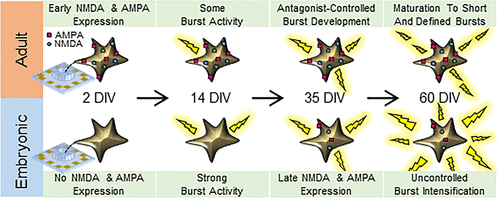当前位置:
X-MOL 学术
›
ACS Biomater. Sci. Eng.
›
论文详情
Our official English website, www.x-mol.net, welcomes your
feedback! (Note: you will need to create a separate account there.)
Comparison of NMDA and AMPA Channel Expression and Function between Embryonic and Adult Neurons Utilizing Microelectrode Array Systems
ACS Biomaterials Science & Engineering ( IF 5.4 ) Pub Date : 2017-11-13 00:00:00 , DOI: 10.1021/acsbiomaterials.7b00596 Darin Edwards 1, 2 , Frank Sommerhage 1 , Bonnie Berry 1, 2 , Hanna Nummer 1 , Martina Raquet 1 , Brad Clymer 1 , Maria Stancescu 1 , James J. Hickman 1, 2
ACS Biomaterials Science & Engineering ( IF 5.4 ) Pub Date : 2017-11-13 00:00:00 , DOI: 10.1021/acsbiomaterials.7b00596 Darin Edwards 1, 2 , Frank Sommerhage 1 , Bonnie Berry 1, 2 , Hanna Nummer 1 , Martina Raquet 1 , Brad Clymer 1 , Maria Stancescu 1 , James J. Hickman 1, 2
Affiliation

|
Microelectrode arrays (MEAs) are innovative tools used to perform electrophysiological experiments for the study of electrical activity and connectivity in populations of neurons from dissociated cultures. Reliance upon neurons derived from embryonic tissue is a common limitation of neuronal/MEA hybrid systems and perhaps of neuroscience research in general, and the use of adult neurons could model fully functional in vivo parameters more closely. Spontaneous network activity was concurrently recorded from both embryonic and adult rat neurons cultured on MEAs for up to 10 weeks in vitro to characterize the synaptic connections between cell types. The cultures were exposed to synaptic transmission antagonists against NMDA and AMPA channels, which revealed significantly different receptor profiles of adult and embryonic networks in vitro. In addition, both embryonic and adult neurons were evaluated for NMDA and AMPA channel subunit expression over five weeks in vitro. The results established that neurons derived from embryonic tissue did not express mature synaptic channels for several weeks in vitro under defined conditions. Consequently, the embryonic response to synaptic antagonists was significantly different than that of neurons derived from adult tissue sources. These results are especially significant because most studies reported with embryonic hippocampal neurons do not begin at two to four weeks in culture. In addition, the utilization of MEAs in lieu of patch-clamp electrophysiology avoided a large-scale, labor-intensive study. These results establish the utility of this unique hybrid system derived from adult hippocampal tissue in combination with MEAs and offer a more appropriate representation of in vivo function for drug discovery. It has application for neuronal development and regeneration as well as for investigations into neurodegenerative disease, traumatic brain injury, and stroke.
中文翻译:

利用微电极阵列系统比较胚胎和成年神经元的NMDA和AMPA通道的表达和功能
微电极阵列(MEA)是用于执行电生理实验的创新工具,用于研究分离培养的神经元群体中的电活动和连通性。依赖源自胚胎组织的神经元是神经元/ MEA混合系统乃至整个神经科学研究的普遍局限性,而使用成年神经元可以更紧密地模拟完整功能的体内参数。同时记录了在MEA上培养长达10周的胚胎和成年大鼠神经元的自发网络活动,以表征细胞类型之间的突触连接。使培养物暴露于针对NMDA和AMPA通道的突触传递拮抗剂,这揭示了成体和胚胎网络在体外的受体谱显着不同。另外,在体外五周内评估了胚胎和成年神经元的NMDA和AMPA通道亚单位表达。结果确定,在确定的条件下,胚胎组织的神经元在体外几周内不会表达成熟的突触通道。因此,对突触拮抗剂的胚胎反应与成年组织来源的神经元的反应显着不同。这些结果尤为重要,因为大多数关于海马胚胎神经元的研究报告都不是在培养两到四周后才开始的。另外,利用MEA代替膜片钳电生理学避免了大规模的劳动密集型研究。这些结果建立了这种源自成年海马组织与MEA结合的独特杂交系统的实用性,并为药物发现提供了更合适的体内功能表征。它可用于神经元的发育和再生以及神经退行性疾病,脑外伤和中风的研究。
更新日期:2017-11-13
中文翻译:

利用微电极阵列系统比较胚胎和成年神经元的NMDA和AMPA通道的表达和功能
微电极阵列(MEA)是用于执行电生理实验的创新工具,用于研究分离培养的神经元群体中的电活动和连通性。依赖源自胚胎组织的神经元是神经元/ MEA混合系统乃至整个神经科学研究的普遍局限性,而使用成年神经元可以更紧密地模拟完整功能的体内参数。同时记录了在MEA上培养长达10周的胚胎和成年大鼠神经元的自发网络活动,以表征细胞类型之间的突触连接。使培养物暴露于针对NMDA和AMPA通道的突触传递拮抗剂,这揭示了成体和胚胎网络在体外的受体谱显着不同。另外,在体外五周内评估了胚胎和成年神经元的NMDA和AMPA通道亚单位表达。结果确定,在确定的条件下,胚胎组织的神经元在体外几周内不会表达成熟的突触通道。因此,对突触拮抗剂的胚胎反应与成年组织来源的神经元的反应显着不同。这些结果尤为重要,因为大多数关于海马胚胎神经元的研究报告都不是在培养两到四周后才开始的。另外,利用MEA代替膜片钳电生理学避免了大规模的劳动密集型研究。这些结果建立了这种源自成年海马组织与MEA结合的独特杂交系统的实用性,并为药物发现提供了更合适的体内功能表征。它可用于神经元的发育和再生以及神经退行性疾病,脑外伤和中风的研究。











































 京公网安备 11010802027423号
京公网安备 11010802027423号